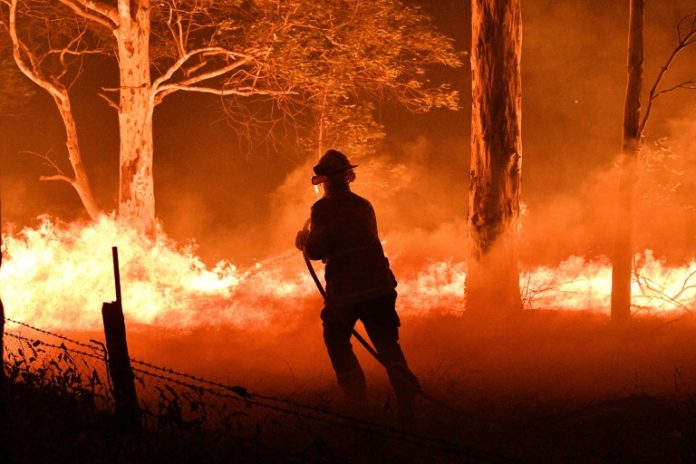Relief supplies began reaching thousands of people stranded in fire-ravaged Australian towns Wednesday after deadly bushfires ripped through popular tourist spots and rural areas leaving at least eight people dead.
Navy ships and military aircraft were deployed alongside emergency crews to provide humanitarian relief and assess the damage from the deadliest spate of blazes yet in a months-long bushfire crisis.
Police said three more bodies were discovered Wednesday, bringing the confirmed death toll since late Monday to eight, including a volunteer firefighter who died when a “fire tornado” flipped his 10-tonne truck.

The latest deaths take to at least 17 the number of people killed in one of Australia’s most devastating bushfire seasons of recent years.
There were mounting fears for several others missing after the country’s southeast was devastated by out-of-control blazes, which destroyed more than 200 homes and left some small towns in ruins.
The fires encircled seaside communities to trap thousands of holidaymakers and locals, cutting electricity and communication services that in many areas remained down late Wednesday.

New South Wales (NSW) Rural Fire Service commissioner Shane Fitzsimmons said emergency services faced a “real challenge” accessing isolated areas to help injured people, at least three of whom were later airlifted out suffering burns.
As fires raged across the country, some of the stranded were taking advantage of temporary road re-openings to return home while others faced a second trying night bedding down in make-shift accommodation.

In the coastal town of Eden, where evacuees were camping at football fields, volunteer Loureen Kelly said food was “running low very quickly” amid panic buying.
“Basic things like bread we ran out of yesterday. We had milk and very low to no fruit in town,” she told public broadcaster ABC, adding that the community had rallied to provide food to the evacuees.
In Mallacoota where 4,000 had huddled on the foreshore as fire swept through, authorities were preparing for the possibility that the town could be cut off for weeks.
Aircraft have begun dropping supplies and ships carrying two weeks’ worth of supplies arrived late Wednesday.

Paramedics reportedly assessed the injured and moved those requiring further treatment to a 25-bed floating medical centre off the coast.
Many people have returned to find their homes burned to the ground, with the task of rebuilding shattered communities expected to take years.
Gary Hinton escaped flames roaring through Cobargo early Tuesday and returned to the stricken town to find his father’s house largely intact, but many other buildings reduced to cinders.
“It wasn’t good. It’s turned out pretty devastating for everyone,” he told media.
Cooler temperatures and easing winds provided a window of opportunity for relief efforts Wednesday, but there were concerns over new fires sparked by lightning in alpine regions.

“There’s a lot of people holidaying, again, up in those areas,” Victoria Emergency Management commissioner Andrew Crisp said. “We’ll be prioritising those (fires) and hitting them as hard as we can. We don’t need any new fires.”
Authorities warned the fire danger would spike on Saturday as temperatures soar again.
“At the very least, weather conditions will be at least as bad as what they were yesterday,” NSW Premier Gladys Berejiklian said.
“That makes this a long and dangerous and complex fight, a long and dangerous process to support everyone who’s been impacted by it,” Victoria Premier Daniel Andrews added.
This season’s blazes have killed at least 17 people, destroyed more than 1,000 homes and scorched about 5.5 million hectares (13.5 million acres) – an area bigger than Denmark or the Netherlands.
For weeks, major Australian cities have been choked by toxic bushfire smoke, and on Wednesday air quality reached hazardous levels in Canberra as visibility in the capital plummeted.
Satellite images showed smoke from the latest fires had blown across the Tasman Sea to reach New Zealand.
The unprecedented crisis has sparked street protests calling on the government to immediately act on climate change, which scientists say is creating a longer and more intense bushfire season.
Conservative Prime Minister Scott Morrison has come under increasing pressure for his response, which has included holidaying in Hawaii as the disaster unfolded and reiterating his steadfast support for Australia’s lucrative – but heavily polluting – coal mining industry.
Officials in Sydney have also been criticised for ignoring calls to cancel the harbour city’s famed New Year’s Eve fireworks display.







